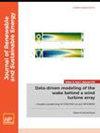利用自组织地图识别科威特附近的风力机制
IF 1.9
4区 工程技术
Q4 ENERGY & FUELS
引用次数: 0
摘要
风能集成的优化需要了解天气模式与其引起的风之间的关系。对于中东这样对天气研究较少的地区来说,气候学变得更加重要。科威特正在开发的沙加亚可再生能源园区就经历了影响风力发电的区域风况。气象研究与预测 (WRF) 模型的输出结果有助于研究最有可能影响沙加亚园区的天气状况。自组织地图(SOMs)机器学习方法将 WRF 输出聚类为中东地区经历的六种主要天气状况。根据 SOM 绘制的风况图,六种风况中的两种在沙加亚公园附近 80 米处的平均风速分别约为 9.9 米/秒和 8.6 米/秒,风速和估计风力分布也更有利于科威特的风力发电。其中一个风系描绘的是强西北风,称为夏季沙马风,第二个风系与强西风有关。其余四个 SOM 节点代表了对科威特风力发电不太有利的体制:局部弱东南风、非洲夜间低空喷流、白天行星边界层以及秋季至春季的局部西北风。其余四个 SOM 节点的平均风速为 5.7-7.2 m s-1,其风速和估计风力分布表明科威特的风力生产条件较差。本文章由计算机程序翻译,如有差异,请以英文原文为准。
Identifying wind regimes near Kuwait using self-organizing maps
Optimization of wind energy integration requires knowing the relationship between weather patterns and winds they cause. For a region with less-studied weather such as the Middle East, climatology becomes more vital. The Shagaya Renewable Energy Park in development in Kuwait experiences regional wind regimes that affect wind power production. Weather Research and Forecasting (WRF) model output allowed investigation into the weather regimes most likely to impact Shagaya Park. The self-organizing maps (SOMs) machine-learning method clustered the WRF output into six primary weather regimes experienced by the Middle East. According to the wind regimes mapped by the SOM, two of the six regimes have average wind speeds of approximately 9.9 and 8.6 m s−1 at 80 m near Shagaya Park, as well as wind speed and estimated wind power distributions that are more favorable to wind power production in Kuwait. One regime depicts a strong northwesterly wind called the summer shamal, and the second is associated with strong westerlies. Regimes less favorable for Kuwaiti wind power production are represented by the remaining four SOM nodes: local weak southeasterlies, an African nocturnal low-level jet, a daytime planetary boundary layer, and local northwesterlies from autumn to spring. The remaining four SOM nodes have average wind speeds of 5.7–7.2 m s−1 and wind speed and estimated wind power distributions which indicate regimes less favorable for wind power production in Kuwait.
求助全文
通过发布文献求助,成功后即可免费获取论文全文。
去求助
来源期刊

Journal of Renewable and Sustainable Energy
ENERGY & FUELS-ENERGY & FUELS
CiteScore
4.30
自引率
12.00%
发文量
122
审稿时长
4.2 months
期刊介绍:
The Journal of Renewable and Sustainable Energy (JRSE) is an interdisciplinary, peer-reviewed journal covering all areas of renewable and sustainable energy relevant to the physical science and engineering communities. The interdisciplinary approach of the publication ensures that the editors draw from researchers worldwide in a diverse range of fields.
Topics covered include:
Renewable energy economics and policy
Renewable energy resource assessment
Solar energy: photovoltaics, solar thermal energy, solar energy for fuels
Wind energy: wind farms, rotors and blades, on- and offshore wind conditions, aerodynamics, fluid dynamics
Bioenergy: biofuels, biomass conversion, artificial photosynthesis
Distributed energy generation: rooftop PV, distributed fuel cells, distributed wind, micro-hydrogen power generation
Power distribution & systems modeling: power electronics and controls, smart grid
Energy efficient buildings: smart windows, PV, wind, power management
Energy conversion: flexoelectric, piezoelectric, thermoelectric, other technologies
Energy storage: batteries, supercapacitors, hydrogen storage, other fuels
Fuel cells: proton exchange membrane cells, solid oxide cells, hybrid fuel cells, other
Marine and hydroelectric energy: dams, tides, waves, other
Transportation: alternative vehicle technologies, plug-in technologies, other
Geothermal energy
 求助内容:
求助内容: 应助结果提醒方式:
应助结果提醒方式:


